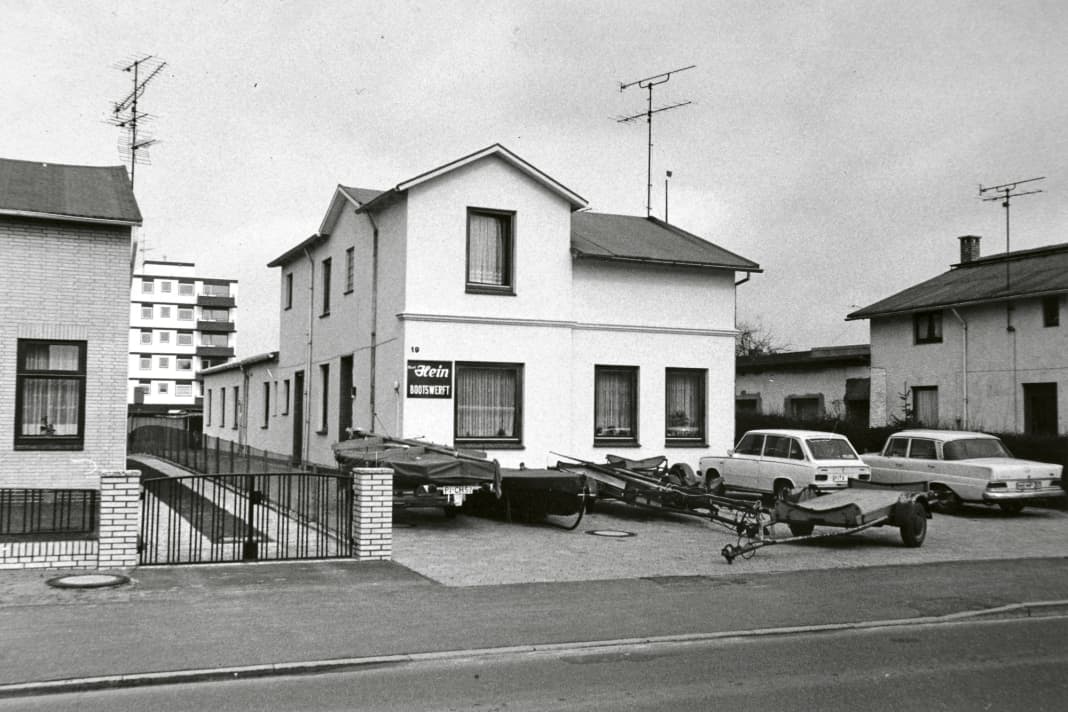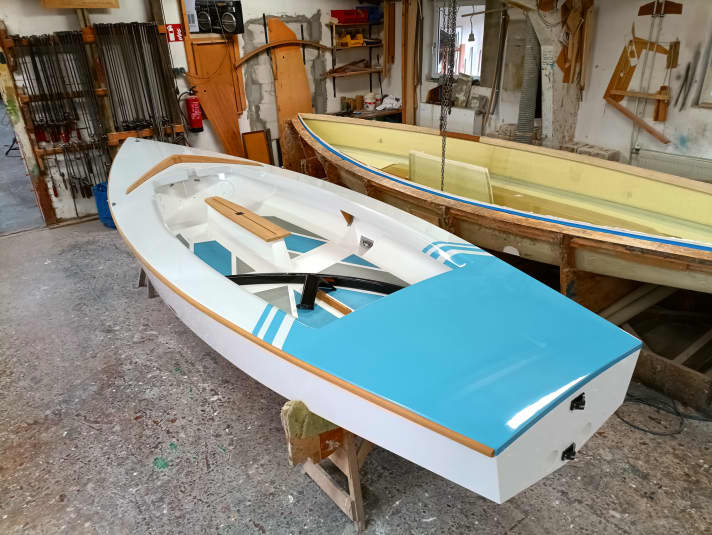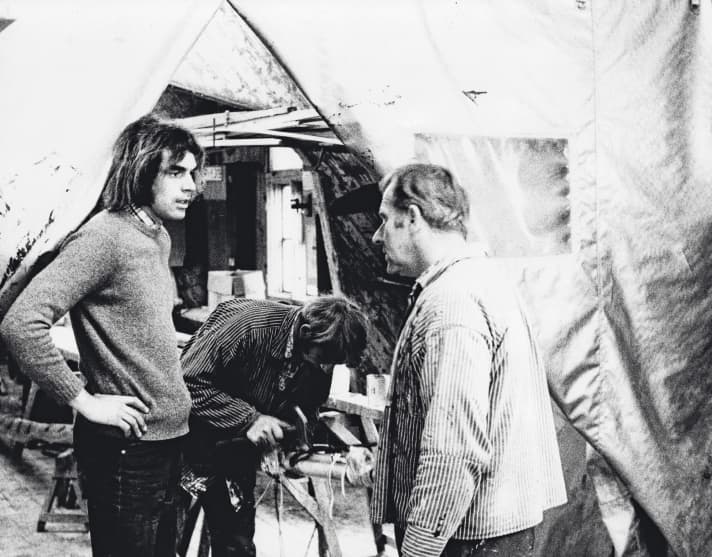





- In 1923 Hein built the first sailing dinghy
- Every detail is carefully considered at Hein
- Hein made a name for himself with the "Pirate"
- From Föhr stripes and robust decks to the shipyard takeover
- Hein's "Kairos" sailed around the world
- Max Billerbeck: Trainee, world champion, boat builder
If you drive past the inconspicuous, beige-brick house in the Elmshorn suburb of Kölln-Reisiek near Hamburg and notice the small sign on the left-hand side of the house, you might suspect anything. A children's day care centre perhaps, or a backyard mail order business? However, hardly anyone would expect to find one of the oldest boatbuilding companies in Germany in this inconspicuous building. It has been around for over a hundred years now.
The Hein family's boatbuilding history actually began in the 19th century. Joiner Johann Hein worked in Wewelsfleth building Elbe cutters and later passed the craft tradition on to his son Gustav. At the end of the First World War, when food and money were scarce and work was hard to find, Gustav Hein had to find a way to feed his family. What could be more obvious than earning his money by building boats again? A former pigsty served as his first own shipyard. Gustav Hein began building wooden rowing boats with high-quality craftsmanship. Boats that the people of Schleswig-Holstein, scarred by the aftermath of the war, could afford.
In 1923 Hein built the first sailing dinghy
Soon afterwards, in 1923, Hein received his first order for a sailing dinghy. He was asked to produce a boat that a customer from Glückstadt had designed entirely according to his own ideas in order to fulfil a small dream. The order harboured a certain risk for Gustav Hein, as the cost of procuring materials changed daily due to inflation. The building therefore had to be completed quickly so that it would be economically viable. His son Gustav junior was the only employee to help.
The sailing dinghy, noted as construction number 1 in the shipyard records, soon won its first regattas, so word quickly spread along the coast that the boat was built "by Hein". Hein senior had already bought the house in Kölln-Reisiek in 1908, where the shipyard is still located today. At that time, however, he had no intention of building boats there, but the garden was large enough to build a shed. A trade was registered, and so began the history of the Hein family's sailboat building business exactly one hundred years ago. A success story that has produced over 2,000 boats to date.
However, it took a few years for a shipyard to become established. The Hein family was not picky when it came to accepting orders. "Taking on roof work, plastering and tarring" is written on the plaque on the house wall in a photo dated 1928. Over time, however, more and more boat orders came in. And today, a sign still hangs there that reads "Hein Bootswerft".
Every detail is carefully considered at Hein
Jürgen Hein is still involved with the shipyard in the fifth generation, although he handed over the management to Steffen Radtke and Max Billerbeck a few years ago. Although the two are not part of the Hein family, they know how to continue the tradition and boatbuilding heritage of this established family business with care and conscientiousness. Hein dinghies are still sailing at the top of the rankings.
"I believe that the secret of our boats' success is simply the love and precision with which we build our dinghies," says Steffen Radtke. Mass production is alien to this traditional company. Each hull is built by hand, moulding by moulding and mat by mat, celebrating the old art of boat building. To ensure that the boats have exactly the right weight at the end, Jürgen Hein even weighed all the individual parts when developing and designing a new model before he started building it. "Many people do it the other way round: they build first and then realise that the boat is too heavy or too light," says Radtke. But things have always been different at Hein Bootsbau. Every fitting, every screw is carefully considered. "That's what makes the difference to other boats," says Radtke.
This was already important to Gustav Hein when he started rowing boats. "Many years ago, I got a call from a hotel in Schleswig-Holstein saying that they had a few of Hein's rowing boats that needed a refit," says Steffen Radtke. "So I went there, and sure enough, they must have bought ten or twelve boats that had been travelling on a lake there for more than 50 years."
Hein made a name for himself with the "Pirate"
When the dinghy designer Carl Martens won a competition in YACHT in 1938, boat building and especially dinghy building really took off at Hein, as the new "10 m² standardised youth dinghy" was in great demand. The name had to be fine-tuned at first, but after another YACHT competition, the boat was named "Pirat". To this day, it is the most frequently built boat at Hein, the boat with which the shipyard has made a name for itself.

"When we built the first GRP Pirate, there was trouble at the regattas at first," remembers Jürgen Hein and launches into an anecdote, of which there are, of course, many in a hundred years of shipyard history. "The first GRP Pirate was sailed by Andreas Haubold and Harald Wefers at the Travemünde Week in 1975," recalls Jürgen Hein. "They literally sailed away from all the other boats and even caught up with the last migratory birds." YACHT also wrote in issue 17/75: "Their five victories in five races made them doubt even the correctness of the ship." The other Pirate sailors promptly filed a measurement protest, as it was assumed that this first GRP Pirate was many times lighter than the wooden models. It was re-measured twice. "Everything was fine, completely within limits," says Jürgen Hein. "The success was not only due to the well-built boat, but also to the fact that the two Finn and OK dinghy sailors Haubold and Wefers were simply much fitter than the other Pirate sailors." For many years, the Pirate was then built from GRP with a plywood deck, until the easy-care GRP finally became established for the decks as well.
From Föhr stripes and robust decks to the shipyard takeover
"I wouldn't be here without the red pirates," says Radtke. As head of the youth department at the Wyker Yacht Club, Radtke ended up at Hein in 2010 and commissioned two pirates. "There was already a red pirate, so the club wanted two more boats with a red deck. Hein had already been switching from plywood to GRP decks for several years. "When I went to the shipyard to look at the boats, I was surprised at the three white stripes on the side of the deck," recalls Radtke. He was then told that there had been a small problem when moulding the deck and therefore decorative stripes had been painted over it. Because all the boats had to look the same, they all had stripes. "They are still called Föhr stripes today and can be ordered as an extra," says Radtke.
But the incident with the deck had further consequences. "The boats were intended as training boats, and when we had low water, the children had to jump from the pontoons very low onto the deck," explains Radtke, "so my requirement was that the deck had to be able to withstand such jumps." Together, Steffen Radtke and Jürgen Hein developed a new, slightly stronger deck for the GRP pirates. The joint project turned into a partnership, followed by the takeover of the shipyard. Today, Jürgen Hein is still a frequent consultant at the shipyard, but has since handed over operations to Radtke and master boatbuilder Max Billerbeck.
Hein keeps dying classes alive
"We still build around ten of the pirates every year," says Radtke. On average, a new build takes 250 hours of labour, including the parts that are pre-produced, such as rudder systems and rubbing strakes. However, the boatyard doesn't just offer pirates, but a much wider range. "Europe, Korsar, Jeton, Vaurien, OK-Jolle and Seggerling," says Radtke, "and more recently also the Dyas, the Contender, the H-26, the Teenie and the old Klepper Fam." The latter was brought to the shipyard by the Fam class association. "The moulds were last at Gruben Bootsbau, but nothing had been produced there for some time. So the class association asked us if they could buy the moulds and make them available to us so that a Fam could still be ordered occasionally and the class wouldn't die out," explains Radtke. He is not yet able to estimate how great the demand will be. "But of the other boats whose moulds we have, we still build one per year on average."
The constant contact with sailing professionals has really helped us to develop good boats. After all, who can provide better input?"
Jürgen Hein fondly remembers the time of experimentation in the sixties and seventies. "At that time, Christian and Thomas Jungblut were here all the time, discussing ideas and improvements with my father Kurt and simply trying things out," describes Hein. "The Jungbluts had plywood OK dinghies, but wanted a GRP hull, so Kurt built a mould for it," says Jürgen Hein. "They were even sandwich moulds with a foam core back then, but there were no vacuum pumps yet." Instead, Kurt Hein filled plastic bags with sand and used them to press the foam onto the resin. "The Jungbluts were constantly coming up with new ideas, which were realised here," says Hein, "Of course, that really helped us to develop good boats. After all, who can provide better input than such sailing professionals?"

Hein's "Kairos" sailed around the world
Of course, there have also been some unusual orders over the decades. "Kurt once built a fishing boat and some OK dinghies as rowing boats," recalls Hein. "They were really excellent for use as rowing boats." But none of the shipyard bosses were open to overly abstruse projects. They knew their core competences and concentrated on them.
"In the fifties and sixties, we also built a lot of dinghy cruisers," says Hein, "first 15s, then 20s and even 30s. Also some keelboats and large motorboats." The shipyard grew with the tasks. "In the beginning, the hall was covered with a tarpaulin, then a mobile hall from the Second World War was added at the back. We needed space." However, the boats were not always built entirely at Hein. "For a while, hulls were also built here," recalls Jürgen Hein, "for example by Sommerfeld." The long list of projects includes a very special boat: a steel dolphin cruiser, commissioned by Ernst-Jürgen Koch. The owner couple sailed around the world from Hamburg on the "Kairos" between 1964 and 1967.
Max Billerbeck: Trainee, world champion, boat builder
While Steffen Radtke takes over the commercial side of the business, master boat builder Max Billerbeck looks after the technical side. At the age of 37, he has been with the company for 22 years and also embodies the future of the shipyard's century-old tradition. "The first time I visited the shipyard, I had an old Europe and actually just wanted to be shown how to repair it," says Billerbeck. A two-week internship was supposed to help. But the spark was ignited, and from then on Billerbeck was often at the shipyard. "Whenever I just wanted to ask something, I was told: 'Stay here, you have to help us with something,'" he recalls. When a pirate in need of repair came up for sale soon afterwards, Max was even given permission to use the timber yard to repair it privately for himself.
When I did an internship at the shipyard, I actually just wanted to be shown how to repair my dinghy"
Both the knowledge he learnt in boat building and the practice with his own boats bore fruit in Billerbeck's sailing career, who later became world champion in the Contender. "In 2004, I started my apprenticeship as a boat builder here at the company," he adds. An apprenticeship that he completed as the best in the country, which enabled him to become a master craftsman just one year later. Billerbeck has been responsible for the boatbuilding side of the shipyard as the second managing director since 2010.
"At the peak, we once had 15 employees," says Jürgen Hein. That was in the heyday of dinghy construction, in the mid-1980s. Today, the shipyard bakes smaller rolls. "But in January we'll be taking on a fourth apprentice," adds Radtke. "Also a pirate sailor." For Radtke, being a sailor himself is an absolute must for working at Hein. "We're not a winter storage company here, we build and optimise dinghies according to customer requirements. You have to have an understanding of why a fitting has to be in a certain place."
Alongside new builds, repairs are one of the shipyard's biggest areas of work. Some customers accept long journeys for this. "A couple have just travelled here from Düsseldorf with their two Europes," says Radtke. "Many of our customers are happy that there is still a shipyard that knows about traditional boatbuilding and where they can have their treasures repaired."

